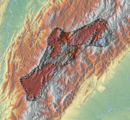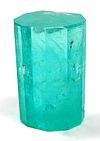Bogotá savanna: Difference between revisions
Tisquesusa (talk | contribs) →Lakes: +1 |
Tisquesusa (talk | contribs) + timeline |
||
| Line 121: | Line 121: | ||
At the arrival of the [[Spanish conquest of the Americas|Spanish]] [[conquistador]]s the region was inhabited by the [[Muisca people|Muisca]] people who lived in hundreds of villages scattered across the plateau. These villages were individually ruled by ''[[cacique]]s'' who at the same time paid tribute to the ''[[zipa]]'', ruler of Bacatá. After the defeat of the [[Muisca rulers]], Bogotá was founded and the Spanish colonizers engaged in the construction of Spanish-style towns to replace all the indigenous villages and in the process of assimilation and religious convert of the Muisca. The majority of those villages kept their indigenous names, but some were slightly modified in time, like ''Suacha'' which became [[Soacha]], ''Hyntiba'' becoming [[Fontibón]] and ''Bacatá'' becoming [[Bogotá]]. |
At the arrival of the [[Spanish conquest of the Americas|Spanish]] [[conquistador]]s the region was inhabited by the [[Muisca people|Muisca]] people who lived in hundreds of villages scattered across the plateau. These villages were individually ruled by ''[[cacique]]s'' who at the same time paid tribute to the ''[[zipa]]'', ruler of Bacatá. After the defeat of the [[Muisca rulers]], Bogotá was founded and the Spanish colonizers engaged in the construction of Spanish-style towns to replace all the indigenous villages and in the process of assimilation and religious convert of the Muisca. The majority of those villages kept their indigenous names, but some were slightly modified in time, like ''Suacha'' which became [[Soacha]], ''Hyntiba'' becoming [[Fontibón]] and ''Bacatá'' becoming [[Bogotá]]. |
||
== Timeline of inhabitation == |
|||
{| class="wikitable sortable mw-collapsible" style="width:80%; margin:auto;" |
|||
| align=center colspan=2 | '''Timeline of inhabitation of the Bogotá savanna, Colombia''' |
|||
|- |
|||
| <timeline> |
|||
Preset = TimeHorizontal_AutoPlaceBars_UnitYear |
|||
ImageSize = width:950 barincrement:20 |
|||
PlotArea = left:20 right:62 bottom:20 top:0 |
|||
Define $bold = fontsize:M shift:(7,-1) |
|||
Colors = |
|||
id:canvas value:rgb(0.97,0.97,0.97) |
|||
id:grid2 value:gray(0.88) |
|||
id:prehistory value:rgb(0.5,1,0.2) |
|||
id:lithic value:gray(0.8) |
|||
id:ceramic value:rgb(0.95,0.9,0.6) |
|||
id:preceramic value:gray(0.7) |
|||
id:hunter value:rgb(0.91,0.87,0.8) |
|||
id:mummy value:rgb(0.81,0.87,0.9) |
|||
id:bochica value:rgb(0.9,0.7,0.8) |
|||
id:agriculture value:rgb(0.5,1,0) |
|||
id:herrera value:rgb(0.9,0.8,0.3) |
|||
id:muisca value:rgb(1,0.84,0) |
|||
id:colonial value:gray(0) |
|||
id:empire value:rgb(1,0,0) |
|||
id:colombia value:rgb(0,0,1) |
|||
id:years value:gray(0.5) |
|||
BackgroundColors = canvas:canvas |
|||
Period = from:-11500 till:2500 |
|||
ScaleMajor = unit:year increment:1000 start:-10500 |
|||
ScaleMinor = unit:year increment:100 start:800 gridcolor:grid2 |
|||
AlignBars = justify |
|||
BarData= |
|||
barset:agriculture |
|||
barset:ceramic |
|||
barset:muisca |
|||
bar:period |
|||
PlotData = |
|||
# set defaults |
|||
width:15 fontsize:M textcolor:black align:left anchor:from shift:(3,-5) |
|||
barset:agriculture |
|||
from:-10544 till:-3000 color:hunter text:"[[Hunter-gatherer|Hunter-gatherers]]" anchor:middle align:center width:48 |
|||
from:-3000 till:1537 color:agriculture text:"[[Muisca agriculture|Agriculture]]" anchor:middle align:center width:30 |
|||
barset:ceramic |
|||
from:-10544 till:-750 color:preceramic text:"[[Andean preceramic|Preceramic]]" anchor:middle align:center width:15 |
|||
from:-750 till:1536 color:ceramic text:"[[Ceramic]]" anchor:middle align:center width:30 |
|||
from:-500 till:1537 color:mummy text:"[[Muisca mummification|Mummification]]" anchor:middle align:center width:15 |
|||
from:-4400 till:-4340 color:bochica text:"[[Bochica]]" align:left width:25 |
|||
from:1537 till:1539 color:colonial align:left width:120 |
|||
barset:muisca |
|||
from:-11500 till:-10500 color:prehistory text:"[[Prehistory of the Altiplano Cundiboyacense|Prehistory]]" align:left width:40 |
|||
from:-10544 till:-800 color:lithic text:"Lithic" align:left width:20 |
|||
from:-800 till:800 color:herrera text:"[[Herrera Period|Herrera]]" align:left width:30 |
|||
from:800 till:2020 fontsize:L color:muisca text:"[[Muisca people|Muisca]]" align:left width:40 |
|||
from:800 till:1537 fontsize:L color:muisca width:30 |
|||
from:1536 till:1539 color:colonial text:"[[Spanish conquest of the Chibchan Nations|Conquest]]" align:left width:45 |
|||
from:1538 till:1819 color:empire text:" [[Spanish Empire]]" align:left |
|||
from:1819 till:2025 color:colombia text:" [[History of Colombia|Colombia]]" align:left |
|||
from:-10544 till:-10444 fontsize:S color:colonial text:" [[El Abra]]" align:left width:10 |
|||
from:-9800 till:-9700 fontsize:S color:colonial text:" [[Tibitó]]" align:left width:10 |
|||
from:-6500 till:-6400 fontsize:S color:colonial text:" [[Checua]]" align:left width:10 |
|||
from:-1400 till:-1300 fontsize:S color:colonial text:" [[Lake Herrera]]" align:left width:10 |
|||
from:2016 till:2025 fontsize:S color:colonial text:" [[BD Bacatá]]" align:left width:10 |
|||
from:-10000 till:-9900 fontsize:S color:colonial text:" [[Piedras del Tunjo Archaeological Park|P. del Tunjo]]" align:left width:10 |
|||
from:-8500 till:-8400 fontsize:S color:colonial text:" [[Aguazuque]]" align:left width:10 |
|||
from:-9100 till:-9000 fontsize:S color:colonial text:" [[Tequendama]]" align:left width:10 |
|||
</timeline> |
|||
| valign=top | [[File:Altiplano Cundiboyacense (subdivisions).png|center|130px]]<br><center><small>'''[[Altiplano Cundiboyacense|Altiplano]]'''</small></center><br>[[File:Mapa del Territorio Muisca.svg|center|130px]]<br><center><small>'''[[Muisca Confederation]]'''</small></center><br>[[File:Sabana de Bogota.png|center|130px]] |
|||
|- |
|||
|} |
|||
== Cities == |
== Cities == |
||
Revision as of 00:50, 17 June 2016

The Bogotá savanna is a high plateau located in the center of Colombia in the Eastern Ranges of the Colombian Andes. It is the southern part of a larger plateau called Altiplano Cundiboyacense that rises to an average altitude of 2,600 metres (8,500 ft) above sea level.
This plateau is crossed from north to south by the Bogotá River, which at the southwestern edge of the plateau forms the Tequendama Falls (Salto del Tequendama). Other rivers, tributaries of the Bogotá river, form smaller valleys with very fertile soils dedicated to agriculture and cattle-breeding.
Etymology
The Bogotá savanna is named after Bogotá, which is derived from Chibcha and means "(Enclosure) outside of the farm fields".[1]
History
The earliest confirmed inhabitation of present-day Colombia was on the Bogotá savanna with sites El Abra, Tequendama and Tibitó, were semi-nomadic hunter-gatherers lives in caves and rock shelters. This prehistorical preceramic period was followed by the Herrera Period.
At the arrival of the Spanish conquistadors the region was inhabited by the Muisca people who lived in hundreds of villages scattered across the plateau. These villages were individually ruled by caciques who at the same time paid tribute to the zipa, ruler of Bacatá. After the defeat of the Muisca rulers, Bogotá was founded and the Spanish colonizers engaged in the construction of Spanish-style towns to replace all the indigenous villages and in the process of assimilation and religious convert of the Muisca. The majority of those villages kept their indigenous names, but some were slightly modified in time, like Suacha which became Soacha, Hyntiba becoming Fontibón and Bacatá becoming Bogotá.
Timeline of inhabitation
| Timeline of inhabitation of the Bogotá savanna, Colombia | |
 |
   |
Cities
The main cities of the Bogotá savanna, in addition to the capital city of Bogotá, are: Mosquera, Soacha, Madrid, Funza, Facatativá, Subachoque, El Rosal, Tabio, Tenjo, Cota, Chía, Cajicá, Zipaquirá, Nemocón, Sopó, Tocancipá, Gachancipá, Sesquilé, La Calera, Chocontá and Guatavita.[2]
Climate
The average temperature of the plateau is 14 °C, but this can fluctuate between 0 °C and 24 °C. The dry and rainy seasons alternate frequently during the year. The dry months are December, January, February and March. During the rainy months the temperature tends to be more stable with variations between 9 °C and 20 °C. June, July and August are the months that present the largest variations of temperature, and during the morning frost is regular, which has a negative impact on agriculture. Hail or ice storms are also common.
Hydrology
There is a system of swamps (humedales) that regulate the soil moisture acting like sponges for the rain waters. The most important wetlands are: La Conejera, El Burro, Jaboque, Santa María del Lago, Tibabuyes, Córdoba and Guaymaral.
Rivers
Lakes
Waterfalls
Panorama
See also
References
- ^ Template:Es Etymology Bacatá - Banco de la República
- ^ Cities on the Bogotá savanna


